![]()
![]()
![]()
Use LEFT and RIGHT arrow keys to navigate between flashcards;
Use UP and DOWN arrow keys to flip the card;
H to show hint;
A reads text to speech;
20 Cards in this Set
- Front
- Back
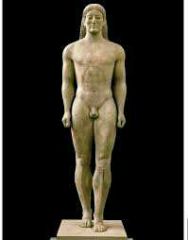
|
Name: Anavysos KourosDate: 530 B.C.E.Period/Style: Archaic GreekArtist: UnknownPatron: N/ALocation: GreeceMatirial: Marble with paint remnatsFunction: Grave markers, or offering to a godContext: found by a youth's grave, who died in battleDescription: left foot forward, knees are locked, braided hair with head band, |
|
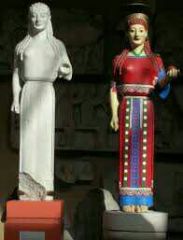
|
Name: Peplos KoreDate: 530 B.C.E.Period/Style: Archaic GreekArtist: UnknownPatron: N/ALocation: Acropolis, GreeceMaterial: Marble with painted detailsFunction: offering/reprisenation of a goddessContext: thought to be an offering to Athena, later discovered to be a statue of Artemis or AthenaDescription: arm straight out, thought to be carring something, holes in head thought to be wearing a metal crown, paint visible in speaial lighting on the dress, archaic smile |
|
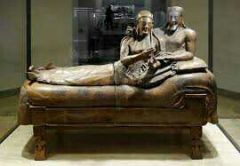
|
Name: Sarcoughagus of the Spouses Date: 520 B.C.E. Period/Style: Etruscan, Archaic period. Artist: Unknown Patron: N/A Location: Cerverteri, Italy Material: Terra cotta Function: Sarcoughagus containing the ashes of the deceased; funerary monument Context: The couple are lounging on a banquet couch for what might be a funeral banquent for the dead. Although the figures are at rest, they convey far more animation than the stiff, formal Egyptian tomb sculptures. There is some disregard for portion and balance - the legs were only summarily modeled while the upper half of the figures are much more detailed. The sculptor focused on the vibrant faces and the gesticulating arms. Description: Detail in hair color; portrayed women's relative freedom in Etruscan society; terracotta, funerary monument, sarcophagus, gender relations/ gender roles, expressive figures, unrealistic proportions |
|

|
Name: Apulu (Apollo) from VeiiDate: 510-500 B.C.E.Period/Style: Etruscan, Archaic periodArtist: Vulca (possibly)Patron: Etruscan king of Rome, Tarquinius SuperbusLocation: The roof of the Portonaccio temple, Veii, ItalyMaterials: Temple - wood, mud bricks, tufa (volcanic rock); Sculpture - terracottaFunction: Temple rooftop statueContext: The statue is part of a group of at least four other painted terracotta figures that adorned the temple roof. They depicted one of the twelve labors of Hercules. The bright paint and the style of drapery are reminiscent of Archaic korai, but the figure's vigorous motion, gesticulating arms, animated face, and overall energy and excitement are distinctly Etruscan.Description: Figure is energetic and excited; movement; terra cotta, statuary, mythology |
|

|
Name: Tomb of the TricliniumDate: 460-450 B.C.E.Period/Style: EtruscanArtist: UnknownPatron: N/ALocation: Tarquinia, ItalyMaterials: Tufa, frescoFunction:Context:Description |
|
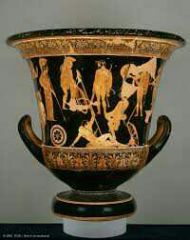
|
Name: Niobides KraterDate: c. 460-450 B.C.E.Period/Style: Classical GreekArtist or Architect: Niobid PainterOriginal Location: N/ACurrent Location: Museum of Louvre, ParisMaterial/technique: Clay, red-figure technique (white highlights)Function: Vase; worshippingContext: The engraved figures are the Greek Gods Apollo and Artemis killing the children of Niome. Generally accepted it is the Gathering of Argonauts or Polynotos of Thasos.Descriptive Terms: Attempt at three dimensions, red-figure style, Greek |
|

|
Name: Name: Doryphoros (Spear Bearer)Date: 450-440 B.C.E.Period/Style: Greek; Classical realism; contrappostoArtist: PolykleitosPatron: N/AOriginal Location: HerculaneumCurrent Location: Naples National Archaeological MuseumMaterials: MarbleFunction: Depiction of the (ideal) human bodyContext: N/ADescription: Contrapposto, realism, muscular, iconic, balanced portions of the human body(Spear Bearer)Date: 450-440 B.C.E.Period/Style: Greek; Classical realism; contrappostoArtist: PolykleitosPatron: N/AOriginal Location: HerculaneumCurrent Location: Naples National Archaeological MuseumMaterials: MarbleFunction: Depiction of the (ideal) human bodyContext: N/ADescription: Contrapposto, realism, muscular, iconic, balanced portions of the human body |
|

|
Name: Grave stele of HegesoDate: 410 B.C.E.Period/Style: GreekArtist: Kallimachos Patron: N/ALocation: Kerameikos(found); National Archeological Museum, Athens(current)Materials: Pentelic marble and paintFunction: A grave stone honoring the deadContext: It is a grave Stelae, and the deceased is Hegeso, the daughter of ProxenosDescription: Used to honor the dead, marble, damaged/broken off on the Hegeso's head |
|

|
Name: ParthenonDate: c. 447-424 B.C.E. (Acropolis); 447-438 BCE (Parthenon)Period/Style: GreekArtist: Iktinos and Kallikrates(architects); Phidias(sculptor)Patron: Greek governmentLocation: Athens, GreeceMaterials: Marble, stone, used mathematicsFunction: Architecture, to house the gods and to be a treasuryContext: Dedicated to the God Athena, symbol of Athenian democracy and western civilizationDescription: Large(228ft by 101ft); columns, religious
|
|
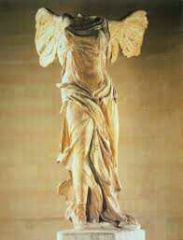
|
Name: Nike of SamothraceDate: c. 200-190 BCEPeriod/Style: Hellenstic Greek/Ancient GreekArtist: UnknownPatron: N/ALocation: Samothrace, GreeceMaterials: MarbleFunction: Naval victoryContext: It is the Greek goddess Nike, and it was made not only to honor her, but a sea battle. Description: humanistic culture, polytheism, wings, GoddessSource: Gardner |
|

|
Name: Great Altar of Zeus and Athena (at Pergamon)Date: c. 175 B.C.E.Period/Style: Hellenistic GreekArtist: King Eumenes IIIPatron: N/ALocation: Asia MinorMaterials: MarbleFunction: WorshipContext: Shows the battle between the Olympian Gods and the Giants, and depicts the life of TelephusDescription: Very large and deep |
|

|
Name: House of the VettiiDate: 2nd century B.C.E.; rebuilt 62-79 C.E. Period/Style: Roman Republic/Pompeii and the cities of VesuviousArtist: UnknownPatron: N/ALocation: Pompeii, ItalyMaterials: cut stone and frescoFunction: Atrium/townhouse. Somtimes a stage in which daily life rituals and displays of social hierarchy were performed. Context: Named after Aulus Vettius Conviva and Aulus Vettius Restitutus. It's a Roman townhouse. The volcanic eruption in Pompeii preserved much of the architecture of the cityDescriptive terms: Domus Architecture, townhouse, stone, wall paintings, fresco |
|

|
Name: Alexander Mosaic from the House of Faun, Pompeii Date: c. 100 BCE Period/Style: Greek Artist/Architect: Unknown Patron: citizen of Pompeii Original Location: House of the Faun, Pompeii Material/Technique: Mosaic Function: Decoration Context: Depicts the moment when the battle between Alexander the Great and Darius turned in Alexander's favor; political art Descriptive Terms: Complicated, political, foreshortening |
|

|
Name: Seated Boxer Date: c. 100 BCE Period/Style: Hellenistic Greek (towards end of Greek period) Artist/Architect: Unknown Patron: Unknown Original Location: buried under the Quirinial – one of the seven hills of Rome Material/Technique: Bronze – lost wax casting; some copper worked into the bronze to appear to be wounds Function: Might be a depiction of an actual athlete from the time, or decorative (?) Context: Most Greek statues depicted ideal human forms (young, beautiful athletes); religious connections Descriptive Terms: Depicts an old, ugly athlete who appears to have been defeated |
|

|
Name: Head of a Roman patrician Date: c. 75-50 BCE Period/Style: Republican Roman Artist/Architect: Unknown Patron: Roman patrician Original Location: Rome, Italy Material/Technique: Marble Function: Bust of important citizen; political art Context: Idealized portrayal of patrician - shows dignity of age (ideal for politicians of the time) Descriptive Terms: |
|
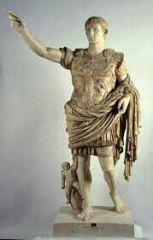
|
Name: Augustus of Primaporta Date: 20 CE Period/Style: The Early Empire/Roman Art Artist/Architect: Unknown Patron: Tiberius Caesar Original Location: Rome, private residence. Found at Livia's villa at Primaporta Material/Technique: Marble Function: Commemorative monument. A vehicle of political propaganda. Context: Political art – advertised Augustus qualities. Depicts the emperor in his role as general and is based closely on Polykleitos's Doryphoros. Cupid is at his feet. Current events are referenced on Augustus's cuirass. Descriptive Terms: political, idealized, military motifs |
|

|
Name: Colosseum (Amphitheatrum Flavium) Date: c. 70-80 CE Period/Style: Imperial Roman Artist/Architect: N/A, but Titus dedicated it to Vespasian Patron: Vespasian Original Location: Rome, Italy Material/Technique: Stone and concrete Function: Amphitheater with 100 days of games like animal fights and gladiatorial battles, then, after years of neglect, it was used ofr materials in the 18th century Context: Could hold between 50,000 and 80,000 spectators which were organized by social ranking, largest ampitheater in the Roman Worlds, freestanding unlike most other ampitheaters which were built into hillsides, included doric, ionic, and carinthian orders Descriptive Terms: Amphitheater, columns, doric, ionic, carinthian, concrete, stone, entertainment |
|

|
Name: Market of Trajan Date: 106-112 CE Period/Style: Ancient Rome Patron: Emperor of Trajan Artist/Architect: Apollodorus of Damascus Original Location: Rome, Italy Material/Technique: Architecture: brick and concrete; column: marble Function: Dedicated to Emperor Trajan in honor of his victory over Dacia, a collection of warehouse and shops where Romans could conduct business and purchess goods Context: Political art that celebrated rulers, carved into the side of a hill " |
|

|
Name: Pantheon Date: 125 CE Period/Style: High Empire/Roman Art Artist/Architect: Unknown Patron: Unknown Original Location: Rome, Italy Material/Technique: Concrete with stone facing Function: First used as a temple, then as a church. The temple for all of the gods. Context: Well-preserved Roman temple that was repurposed throughout the years. Work on the Pantheon started immediately after Hadrian became emperor. The dome's summit is the same distance from the floor as the diameter of the dome: 142 feet. This is so the interior space can be imagined as the orb of the earth. The dome was meant to be imagined as the vault of the heavens. Descriptive Terms: Domes, geometric organization/decoration, Corinthian columns, coffers (sunken, decorative panels) |
|

|
Name: Ludovisi Battle Sarcophagus Date: c. 250-260 CE Period/Style: Late Imperial Roman Artist/Architect: Unknown Patron: Unknown Original Location: Near Porta Turbatina Material/Technique: Proconnessian Marble Function: Tomb, memorial, sarcophogus Context: A memorial to the wars between the Ostrogoths and Imperial Romans then taking place Descriptive Terms: Relief sculpture, figures are crammed together in contrast to the Roman convention of having open space around figures, anti-classical, military heroes, master carving |

